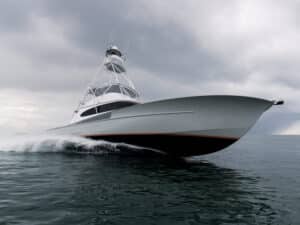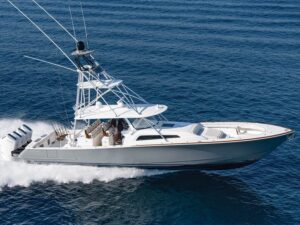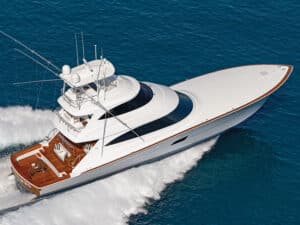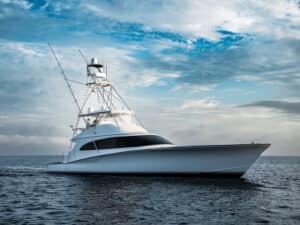
JimSmith_64_02
I believe it was Robert Louis Stevenson who said, “Security is man’s own worst enemy.”
Sometimes, change is good. Jim Smith boats have always been known for sleek, rakish lines, ultrahigh speed and super-lightweight construction. But recently, Jim Smith Boats has embraced what is perhaps the greatest change in philosophy I’ve ever witnessed in a custom-boatbuilding company: Its new boats aren’t quite as fast as in days of yore. Many older Jim Smiths ran close to 50 knots in flat water. The 64 I tested recently still ran over 40 knots, but, more important, it can do it in a 4- to 6-foot sea.
Donald Blount, perhaps the foremost designer of high-speed yacht hulls today, calculated the design parameters and penned the hull lines for the new-breed boats, including Stan and Joan Walker’s new boat, Se7en, which represents No. 4 of the company’s new ilk. John Vance opines, “I told Blount that we already had boats that ran fast. What I wanted from him was to improve our ride quality.” And Vance doesn’t call the construction cold molded anymore. “We prefer to call it Okume wood composite. The glass skins more than double the strength of straight cold molding, so our hulls are stronger and lighter than before,” he explains.
“It’s really amazing how close they can come to the computer models of a design, matching what they say it can do, to what the boat actually can do on the water,” says Walker. “Blount said it would run 41 knots, and running light and without the tower we got it to 42.”
**Performance
**The laws of physics dictated one reason for slowing Jim Smith boats down a notch. Speed requires fuel. “I wanted to have the range to go to the Cocos Islands or the Galapagos, and I wanted the ability to be self-sufficient,” says Walker. So the boat needed to be more fuel-efficient, as well as more seakindly. At the same time, Walker, who previously owned an old classic Hatteras, wanted more speed than what he had. “I can’t cruise at 20 knots anymore.” Did the compromise work? Walker took his boat to Bermuda for the Big Game Classic billfishing tournament last summer and made the 700-plus-mile crossing in 30 hours with plenty of fuel left over.
I ran the boat out of Stuart, Florida, recently. Outside the jetties, we met an east wind at 20 knots and 4- to 6-foot seas – just the type of conditions older Jim Smiths had to slow down in. Not Se7en. While we didn’t run her wide open yet, we headed straight into it at 35 knots and had a remarkably dry ride. Turning beam-to, we bumped it up to 38 knots turning 2,150 rpm – still smooth and dry. We topped out at 40 knots burning 150 gph total. With the rudders hard over, this 64 gracefully banks into turns without sliding.
Illogically, many offshore racing boats run more smoothly and efficiently in a head sea when running faster than what one might consider a more prudent speed. The same holds true with this Jim Smith 64. Just like Contenders, Donzis and other high-performance SKA-type boats, Se7en boasts a 24-degree deadrise at the transom. And with virtually no bow rise, the Jim Smith 64 rose onto plane in just seven seconds. For a 64-footer, that’s amazing!
**Fishability
**”I built this boat for one thing,” says Walker. “That’s catching big fish all over the eastern United States, the Caribbean, both sides of South America and the Pacific.” That means he needs to carry large quantities of frozen bait, along with a complete arsenal of fishing tackle from the lightest to the heaviest, and have a safe workable cockpit. Not to mention a boat that raises fish.
Innovative storage for the bent-butt big guns can be found beneath the settee in the salon. All the light tackle rests under the flybridge settee, and the cockpit offers plenty of freezer space for bait.
Dead idle, without the use of trolling valves, carries Se7en along at just over 8 knots – a good lure-trolling speed for marlin. At such speed, I saw very little surface turbulence in the wake and modest prop wash that disappears no more than 20 feet behind the transom. Winning the Bermuda Big Game Classic and doing exceptionally well in the St. Thomas Boy Scout Tournament – both highly competitive events – attest to the fact that the boat raises fish. Of course, the 46-foot quadruple-spreader riggers from Rupp help by covering an awfully wide expanse of water.
Se7en drifts at a 90-degree angle to the wind and seas in very stable fashion. And for those who claim that a boat this size can’t fight a fish effectively, I offer this: It spun readily with wheel and gears and backed down at almost 8 knots. What little water came in around the tuna door disappeared down the oversized scuppers in a flash. I can’t imagine a more comfortable boat to fish, especially in big seas.
I also noted that the tuna door and the covering board were all one piece. It’s much easier to just open the door rather than lift and fold over a cap rail and then open the door.
**Flybridge
**This flybridge serves three functions: driving the boat, a storage area and entertaining guests.
From the captain’s standpoint, Hynautic power steering, single-lever controls, Murray Brothers helm chairs with solid 4-inch stanchions, and the recessed Miya Epoch computerized electric teaser reels overhead make for a very comfortable helm station. Vision both fore and aft is superb. Docking alongside requires a short stroll to the rail. In case of emergency, the very handy coffee table/box, forward of the helm console settee, with its handsome tabletop, contains the life raft and lifejackets.
From the guest’s perspective, sit or stretch out for a nap on the bench seating to port, starboard and in front of the helm. Walker’s wife asked for a canted, removable seat back on the starboard settee, effectively creating an aft-facing chaise lounge so she can comfortably keep an eye on the spread from the flybridge.
You can actually wash down the entire boat before you ever get back to the dock, thanks to freshwater hose fittings in the tuna tower, the bow, the flybridge and the cockpit.
**Engine Room
**The mezzanine seating covering the engine access lifts on rams. But a secondary hatch must also be opened to climb down. It takes a bit more effort, but the gain in sound insulation is worth it. Interestingly, the engine companionway has no ladder. The entrance is a tad tight for someone my size; however, once in the engine compartment the work space is quite large and spacious.
Thankfully, both 22.5-kW generators abut the aft bulkhead, so the living quarters stay quiet. All the batteries hide under a finished cover on centerline in the bilge – a great place from both weight placement and access standpoints. A 1,200-gallon-per-day reverse osmosis watermaker means you can have healthy potable water and take long showers no matter where you roam.
Of course, the engine room surface shines with a nonporous painted finish, making maintenance much easier.
**Cockpit
**Jim Smith came up with more good ideas for the cockpit. For example, the stainless-steel drawers feature mesh bottoms so wet tackle doesn’t just grow mold and mildew. Again, you find storage everywhere. The stairway to the salon hides a refrigerated drink box, and the bait box answers one of my biggest pet peeves about expensive fishing boats. You spend millions of dollars on a boat and you still need to have an Igloo bait cooler in the cockpit? What’s with that?
Jim Smith includes everything you’d expect such a boat to offer, from tackle center and rigging station to teak deck and covering boards. I especially appreciate the hawseholes in the transom corners. That way, you’ll never rub the paint or varnish off your hull no matter how you need to tie up to a dock.
Five rocket launchers run across the back of the flybridge, three more were placed in each tower leg, and the two in each gunwale augment the hidden rod storage throughout the boat. An Eskimo Ice Machine pumps 600 pounds of crushed ice into the fish box every day. And I must say it takes a brave owner to have a varnished transom on a boat that catches as many big billfish as Se7en does. A slashing bill can do horrible things to varnish!
**Interior
**

If I built a boat for myself, it would have a cherry wood interior just like Se7en’s. Cherry has a gorgeous tight grain, takes a finish spectacularly well and isn’t endangered like teak.
Jim Smith designed and built another innovative fixture – a disappearing salon table. Small enough to work as a coffee table, the table raises on a ram and comes complete with hidden leaves that allow it to seat six or more for dining.
One of the most unusual elements is the sliding Japanese-style rice-paper screens on all the salon windows. They work infinitely better than any blind system I’ve ever seen. They allow diffused light through, yet maintain privacy, and won’t slam or bang underway. When viewing Se7en from the dock at night, its with interior lights on, the screens add a fabulous flavor to the look of the boat.
The forward bulkhead in the galley contains a refrigerator freezer at eye level. Different, but it’s nice not having to bend over.
The master cabin boasts a sliding pocket door to allow more room in the cabin for a larger bed. At the touch of a button in one of the hanging lockers, the bed raises on rams revealing more dry storage. In fact, virtually all dead space aboard Se7en has been converted to storage. If you ever filled all the storage space on this boat, you’d have to repaint the boot stripe.
The granite (called Verde Fire) for the counter tops came from Australia. Smith sent it to Europe, where the thick granite was sliced in half and backed with an aluminum honeycomb. This cut the weight of the granite in half without sacrificing strength. The galley island, however, got the full thickness of granite.
The island holds the KitchenAid microwave/convection/hi-speed oven in addition to tons of dry storage. All storage cabinets have drawers or rollout shelves for dishes, glasses and cutlery.
Belowdecks, Smith continues the cherry wood throughout all the staterooms, except for lacewood flooring in the heads. One thing I’ve always disliked about boat showers is that the doors always seem to open outward. This means that when you finish your shower and open the door, all the water runs down onto the floor. Smith opens the shower doors inward to prevent that.
Starboard amidships, the crew’s quarters consist of over/under berths – one fore-and-aft, the other athwartships – and also features a private head with a separate shower.
A centerline island berth in the forward guest cabin and a head with shower round out the sleeping accommodations. Each stateroom has an overhead hatch complete with a sliding blackout cover.
Jim Smith has always made quality boats. I’m glad to see that it now builds boats that the owners want to travel on, rather than just send the crew.
| **SPECIFICATIONS **LOA 64’0″ BEAM 18’0″ DRAFT 5’0″ WEIGHT 75,000 pounds FUEL 1,750 gallons WATER 300 gallons POWER 1,480-hp DDEC/MTU 2000s BASE PRICE $2.75 millionJim Smith Boats 2980 SE Dominica Terrace Stuart, FL 34997-5711 561-286-1172 |







